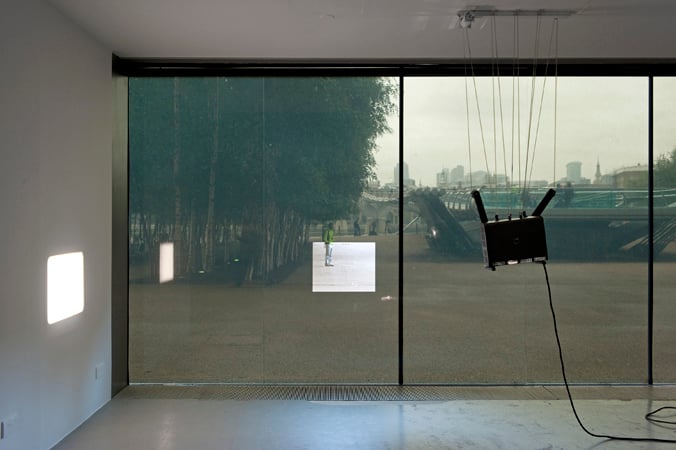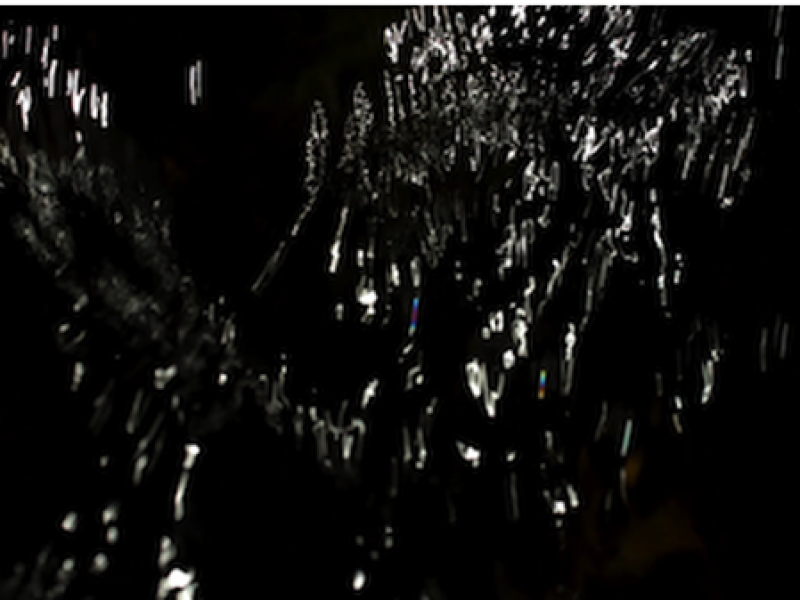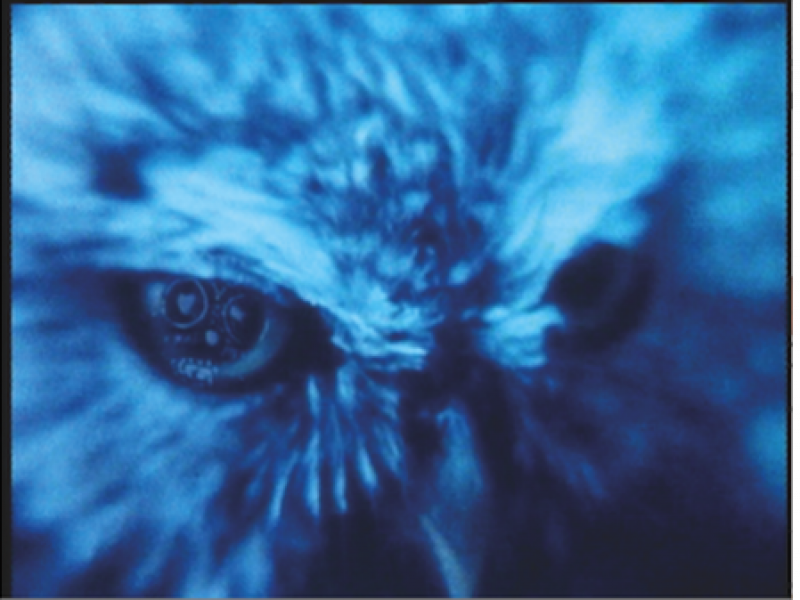Rosa Barba’s sculptural installations bring projected image and recollected language, material and imagined object, into an oppositional and conflating dialogue. The works speculate on the nature of the document not just as a finalised version but as the present tense of reflection – less an act of translation but the continual transposition of material into image and back again. As such, what is understood as history is consecutively reconstituted in the mute veracity of matter, content into form, form into content. Barba has previously shown at LUX’s temporary exhibition space LUX 28 as part of Six Tuesdays After Film as a Critical Practice and also as part of LUX’s Film As A Subversive Art at Zoo Art Fair in 2009. She is currently participating in the Liverpool Biennial, Touched until 18th November 2010, has been nominated for the Nam June Paik Award 2010 and her solo exhibition is now on at Tate Modern’s Level 2 Gallery until the 8 January 2011.
In the following interview, Gil Leung and Barba discuss the historical and material potential of instigating a dialogue between an idea and an object.
Gil Leung: So, I first saw your work at LUX 28 in 2009 and I was really struck by your use of an imaging or visual equipment with an absence of image, the white space – or rather the image was presented as its means. There was this absence of image and the presence of machine or a production of absence if you like.
Rosa Barba: Yes, this work that was at LUX is also in the new show at Tate Modern. The work is called Western Round Table 2027 (2007) and it came out my interest in these The Western Round Table on Modern Art meetings between these future modern male protagonists including Duchamp, Schoenberg, and Frank Lloyd Wright. The first meeting was in 1948 in the Mojave desert but, unlike the next two meetings, was totally undocumented. So, there was this kind of conspiracy around this meeting, like that it took place in a military bunker in the desert, it becomes a conspiracy because it is not recorded but you know it happened. I wanted to give this a shape, a re-enactment. In this way the work is more of a sculpture than a film. There are two projectors speaking to each other. I took an excerpt of two Fellini movies scores written by Morricone and gave each projector a different looping soundtrack. The two projectors present a dialogue, shadows of the protagonists staring at each other. This is a bit what we do with history in general – history is like a sculpture we look at.
GL: What you say about this idea of a document that is not recorded, or this giving a shape to something – how does this relate to your choice to present us with an absence of image? Works like, Time Machine (2007) and Stating the Sublime (2009) have a specific absence of image, whiteness, whereas works like They Shine (2008) or The Long Road (2010) present us with a direct presence of matter. In what sense does this presence of matter and the absence of image relate in your practice?
RB: With my first Super-8 works this was a sort of non-information, white image or black image, which is in a way a lot of information. It was a way into a different layer of narration, editing a lot of white cuts, breaking the narrative. This became more extreme when the works needed no image at all; they became more like sculptures. For instance, the felt piece, I Made a Circuit, then a Second Circuit (2010) when you enter the exhibition has a lamp on it. The image is enacted with light. The light brings it together through the empty letters. The Long Road is very present; it is a whole language, a kind of alphabet of an image engineered in the earth. It is an abandoned racetrack that has gone back into landscape. I am an observer of this document, I suppose I am interested in what a document is, how it relates to reality.
GL: So in some sense, there is this relation to the document, not just as a pre-existent form but as a potential or imagined object – the part that remains behind or the break within the narrative?
RB: I guess the pre-existent form or object is like a side effect of society, I analyse the result of this as a sculpture.
GL: Yes, so like what you were saying earlier about film as sculpture and also history as sculpture: what I find interesting is this notion of this temporal element of history/film as an object, like a sculpture, which we can observe or look at as indeterminate. Something we can make an aesthetic judgement about rather than a conceptual determination upon.
RB: I like the bits that haven’t entered the history – everything is history in this sense, it is left for us, but there are these bits that haven’t been processed yet, that haven’t been claimed as a historical document. I made a work, recently shown at the David Roberts Foundation, called It’s Gonna Happen (2005), which was a re-enactment of the possible dialogue of the Watergate phone call. The two speakers on the call are presented as text, as two images overlapping, so the image is text, you read what you hear. The sound disturbs the visual layer. In another way, I made a piece of work called Outwardly, from Earth’s Centre (2007) around this island in Sweden called Gotska Sandön which is moving a metre every year and I constructed this narrative about how to tie to the island into the sea. Doing this act of tying the island to the sea suddenly turns this object into an idea. I start with a specific subject and I open possibilities up with that. It ends with an aerial shot.
GL: What do you find specific to film, as opposed to video, as a medium that potentialises such a shift or mutability between document and idea?
RB: Film is not the most open medium but I like the limitation it provides. I started to use the camera quite obscurely through photography. I would develop an image in the darkroom and these were like stills, this formed my relationship with how to look at images. With Super-8 there was this specific limit in that I was working with light and it had this performative aspect in that the work would have to be done in three minute takes. So the cuts with the white came from these limitations. This became my language. I used these cuts to break up the film and also the installation, to work with the space. I don’t know how to work experimentally without something that has limits. Video doesn’t have these limitations so I don’t know how to break with that.
GL: Perhaps you need to have rules to break them. Do you have a similar understanding of the document then, as historical, as something that can be shifted, and it what sense is this a political motivation, if at all within your work?
RB: I think that you can only be political if you understand the past – I can only give results, my work is research, not statements, the works are never necessarily finished. It is like how you cannot write sci-fi if you don’t know about the past. I try to put a view onto a different way into history that opens up possibilities, which are maybe open to the future.
GL: Much of your work also utilises textual elements, like your new Printed Cinema 11: Idea in Abstract publication that you will be producing with Afterall for your show, how do you figure the relation between literature and cinema, or text and moving image in your work?
RB: Printed Cinema is another interpretation or translation into printed matter. It allows a dialogue between images and a acts like a visual essay. They function more like a reader, a juxtaposition between images and texts.
GL: So are text and image are interchangeable?
RB: But in some way this relation is musical rather than textual. Black acts as breathing. White is an image. White brings you into another chapter. It is very rhythmic.
GL: Like a punctuation between words or a sustain between notes. There is a really beautiful text by Adorno called Punctuation Marks (Satzzeichen, 1956) where he talks about how language resembles music most as punctuation, as the absence or gaps between words, a non-nominal expression.
RB: Yes, I have been thinking recently that perhaps more is possible from white film light. It is so complex.
GL: It is like that Hollis Frampton text called A Lecture (1968). It is a transcript of a lecture he gave in New York. Similarly to (nostalgia) (1971), Frampton got Michael Snow to record the lecture script on a cassette tape and then he just placed the tape player on a table in the front of the class. He pressed play and then went to the back of the room to operate the projector. The tape narrates a whole series of images and talks about how it is this projector’s white light that is presence, not absence. When there is something placed in front of the light we are seeing absence not presence.
RB: In the image, in the white cinema light, something opens up, another image experience of this landscape. I just did an exhibition called Is it a two-dimensional analogy or a metaphor? (2010) on the island of Vassivière in France [read Ian White’s blog about visiting this project] The lake around the island submerged a village in order to build a dam to power the island. There is a window that has one specific point of view designed to frame the perfect image from the island. For one work, White Museum (2010), I put a 70mm projection of white light out of this window while the sound the celluloid frames this image. So this white light frames nature. Everything can be photographed and becomes a representation, using light to show this landscape in the celluloid just shows what it is – not past, not future – just this little bit with this light.
GL: So there is this framing or shifting, or maybe framing as shifting, the nature of an object and in this sense, a document is not so much the determination of something but the encounter with something as what it is, the relation between presentation and presence.
RB: It is like the possible explanation of a certain image. In my new work, A Private Tableaux (2010) I have been walking underneath the Mersey River recording the subterranean city pumping air through these tunnels. On the ceiling of these tunnels there are these hand made white drawings the engineers make to examine the pressure cracks made by cars overhead. They are like wall paintings or cave drawings. It is nearly impossible to imagine them as functional. They seem to follow a logic or make some shape or other. I wrote a narrative about these images and cut the film with this text, of these possible explanations. There is a sort of dialogue. A question and answer.
Gil Leung is a writer and curator based in London. She is Distribution Manager at LUX and editor of VERSUCH journal.





